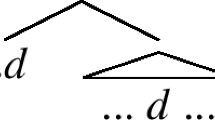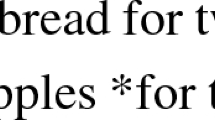Abstract
This paper investigates the semantics of measure phrases in Japanese. Based on new data, we argue that the interpretation of measure phrases in Japanese is sensitive to scale structure such that (i) measure phrases are introduced by a degree morpheme that selects only for gradable predicates whose scale contains a minimal element (i.e., a lower closed scale) and (ii) violations to this restriction are repaired via coercion, which forces a comparative interpretation with a contextually determined standard and hence a minimal element. We compare the Japanese facts to data in other languages and argue that the requirement of having a minimal element is not specific to Japanese, but universal. We show that languages may vary in how they deal with potential violations of this universal constraint, including coercion of a contextually recoverable derived minimal element (Japanese), ungrammaticality (e.g., Spanish, Korean, Russian), and a hybrid system of ungrammaticality for some adjectives and allowed constraint violation for others (e.g., English, German, Italian).
Similar content being viewed by others
References
Bartsch Renate, Theo Vennemann T (1972) The grammar of relative adjectives and comparison. Linguistische Berichte 20: 19–32
Bartsch Renate, Theo Vennemann T. (1973) Semantic structures: A study in the relation between syntax and semantics. Athenäum Verlag, Frankfurt
Beck, Sigrid. To appear. Comparison constructions. In An international handbook of natural language meaning, ed. Claudia Maienborn, Klaus von Heusinger, and Paul Portner. Berlin: de Gruyter.
Beck Sigrid, Toshiko Oda, Koji Sugisaki (2004) Parametric variation in the semantics of comparison: Japanese vs. English. Journal of East Asian Linguistics 13: 289–344
Bolinger Dwight (1972) Degree words. Mouton, Paris
Chierchia Gennaro (1998) Reference to kinds across languages. Natural Language Semantics 6: 339–405
Corver Norbert (1997) Much-support as a last resort. Linguistic Inquiry 28: 119–164
Cresswell, Max J. 1976. The semantics of degree. In Montague grammar, ed. Barbara H. Partee, 261–292. New York: Academic Press.
de Swart Henriëtte (1998) Aspect shift and coercion. Natural Language and Linguistic Theory 16: 347–385
Ernst Thomas B. (1984) Towards an integrated theory of adverb position in English. Indiana University Linguistics Club, Bloomington
Fujii, Tadashi. 1966. Dooshi + te iru no imi (The meaning of V-te iru), Kokugo Kenkyuushitsu 5, Tokyo University, Tokyo. Reprinted in Nihongo dooshi no asupekuto [Aspect of Japanese verbs], ed. Kindaichi, Haruhiko, 27–61 (Tokyo: Mugisyoboo, 1976).
Fukui, Naoki. 1986. A theory of category projection and its applications. Ph.D. diss., MIT.
Grano, Thomas, and Christopher Kennedy. 2010. Mandarin transitive comparatives and the grammar of measurement. Ms., University of Chicago.
Hayashishita, J.-R. 2009. Yori-comparative: A reply to Beck et al. (2004). Journal of East Asian Linguistics 18: 65–100.
Heim, Irene. 2001. Degree operators and scope. In Audiatur Vox Sapientiae: A Festschrift for Arnim von Stechow, ed. C. Féry and W. Sternefeld, 214–239. Berlin: Akademie Verlag.
Jacobsen Wesley M (1992) The transitive structure of events in Japanese. Kurosio Publishers, Tokyo
Kennedy Christopher (1999) Projecting the adjective: The syntax and semantics of gradability and comparison. Garland, New York
Kennedy Christopher. (2001) Polar opposition and the ontology of ‘degrees’. Linguistics and Philosophy 24: 33–70
Kennedy Christopher (2007a) Vagueness and grammar: The semantics of relative and absolute gradable adjectives. Linguistics and Philosophy 30: 1–45
Kennedy Christopher (2007b). Standards of comparison. Handout at ‘Colloque de Syntaxe et Sémantique à Paris’.
Kennedy, Christopher, and Beth Levin. 2008. Measure of change: The adjectival core of degree achievements. In Adjective and adverbs: Syntax, semantics, and discourse, ed. L. McNally and C. Kennedy, 156–183. Oxford: Oxford University Press.
Kennedy Christopher, Louise McNally (2005) Scale structure and the semantics typology of gradable predicates. Language 81: 345–381
Kikuchi, Akira. 2006. On the interpretation of measure phrases in English and Japanese. In Proceedings of Linguistics and Phonetics 2002, ed. S. Haraguchi, O. Fujimura, and B. Palek, 971–980. Prague: Karolinum.
Kindaichi, Haruhiko. 1950. Kokugo dooshi no ichibunrui. Gengo Kenkyuu 15, 48–63. Reprinted in Nihongo dooshi no asupekuto [Aspect of Japanese verbs], ed. Kindaichi, Haruhiko, 27–61 (Tokyo: Mugisyoboo, 1976).
Kindaichi, Haruhiko. 1976. Nihongo dooshi no tensu to asupekuto [Tense and aspect of Japanese verbs]. In Nihongo dooshi no asupekuto [Aspect of Japanese verbs], ed. Haruhiko Kindaichi, 27–61. Tokyo: Mugisyoboo.
Klein Henny (1998) Adverbs of degree in Dutch and related languages. John Benjamins, Amsterdam
Kubota, Yusuke. 2009. Setting the standard, measuring degrees: The semantics of yori ‘than’ phrases and measure phrases in Japanese. Manuscript, The Ohio State University.
Kusumoto, Kiyomi. 2002. The semantics of the non-past –ta in Japanese. Proceedings of the Third Conference on Formal Approaches to Japanese Linguistics, 163–180. MIT Working Papers in Linguistics 41, Cambridge, Mass.
Liu Chen-Sheng Luther (2007) The weak comparative morpheme in Mandarin Chinese. Concentric: Studies in Linguistics 33: 53–89
Matushansky Ora (2002) Tipping the scales: The syntax of scalarity in the complement of seem. Syntax 5(3): 219–276
Moens, Marc. 1987. Tense, aspect and temporal reference. PhD diss., University of Edinburgh.
Nakanishi Kimiko. (2007) Formal properties of measurement constructions. de Gruyter, Berlin
Oda, Toshiko. 2008. Degree constructions in Japanese. PhD diss., University of Connecticut.
Oda, Toshiko. 2010. Contextually restricted scales of i-adjectives in Japanese. Poster presented at FAJL 5, UC Santa Cruz.
Ogihara Toshiyuki (1998) The ambiguity of the –te iru form in Japanese. Journal of East Asian Linguistics 7: 87–120
Ogihara Toshiyuki (2004) Adjectival relatives. Linguistics and Philosophy 27: 557–608
Paradis Carita (2001) Adjectives and boundedness. Cognitive Linguistics 12: 47–65
Pustejovsky James (1995) The generative lexicon. Cambridge University Press, Cambridge
Rotstein Carmen, Yoad Winter (2004) Total adjectives vs. partial adjectives: Scale structure and higher-order modifiers. Natural Language Semantics 12: 259–288
Sawada, Osamu. To appear. The comparative morpheme in Modern Japanese. Proceedings of the 34th annual meeting of the Berkeley Linguistics Society. Berkeley, CA: Berkeley Linguistics Society.
Schwarzschild Roger (2005) Measure phrases as modifiers of adjectives. Recherches linguistiques de Vincennes 34: 207–228
Shirai Yasuhiro (2000) The semantics of the Japanese imperfective –teiru: An integrative approach. Journal of Pragmatics 32: 327–361
Snyder, William, Kenneth Wexler, and Das Dolon. 1995. The syntactic representation of degree and quantity: perspectives from Japanese and child English. In The Proceedings of WCCFL 13, ed. R. Aranovich et al., 581–596. Stanford, CA: CSLI Publications.
Svenonius, Peter, and Christopher Kennedy. 2006. Northern Norwegian degree questions and the syntax of measurement. In Phases of interpretation, ed. M. Frascarelli, 129–157. The Hague: de Gruyter.
Teramura Hideo (1984) Nihongo no Sintakusu to Imi II [The syntax and semantics of Japanese]. Kurosio Publishers, Tokyo
Tsujimura Natsuko (2001) Degree words and scalar structure in Japanese. Lingua 111: 29–52
von Stechow Arnim. (1984) My reaction to Cresswell’s, Hellan’s, Hoeksema’s, and Seuren’s comments. Journal of Semantics 3: 183–199
Xiang, Ming. 2005. Some topics in comparative constructions. PhD diss., Michigan State University.
Author information
Authors and Affiliations
Corresponding author
Rights and permissions
About this article
Cite this article
Sawada, O., Grano, T. Scale structure, coercion, and the interpretation of measure phrases in Japanese. Nat Lang Semantics 19, 191–226 (2011). https://doi.org/10.1007/s11050-011-9070-1
Published:
Issue Date:
DOI: https://doi.org/10.1007/s11050-011-9070-1




